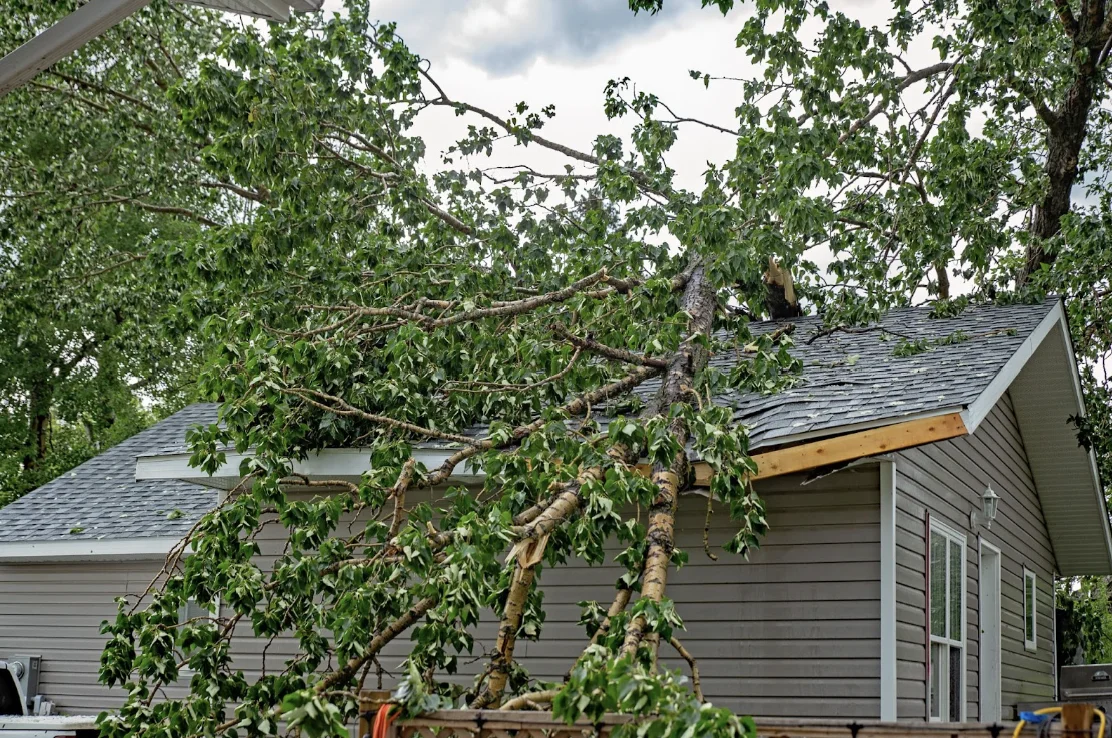The situation can quickly become complicated when a tree falls and causes damage. Homeowners often question whether their insurance policy will cover the resulting damages. The following discussion comprehensively explores how homeowners insurance typically deals with incidents involving fallen trees. It outlines the types of coverage available for property damage and tree removal and the specific conditions that impact these insurance claims.
Coverage for Tree Damage
Damage to Property
Homeowners insurance policies generally cover damage to your home and other structures on your property, such as garages, decks, and fences, if a tree falls on them. However, this coverage typically applies only when the fall is due to factors beyond your control, such as severe weather conditions. The amount covered by insurance will often be minus the deductible, which is the portion of the loss you are responsible for paying.
For example, if a storm causes a tree to topple onto your house, your homeowner’s insurance will likely help pay for repairs and any other affected structures. However, reviewing your policy is crucial to understand precisely what is and isn’t covered.
Tree Removal and Cleanup
In addition to damage repairs, your insurance may also cover the costs of removing the fallen tree and cleaning up the debris, provided the tree fell due to a covered peril like a storm. Policies typically set specific limits for tree removal expenses depending on your insurer and the policy details.
Special Cases of Liability
Damage from Neighbor’s Trees
The situation becomes more complex when a tree falls from a neighbor’s yard. When a tree from your neighbor’s yard falls onto your property and causes damage due to natural events covered by their insurance, your policy will likely cover the damages. However, if the tree falls without causing damage but blocks your driveway, the responsibility to remove it typically falls on you. You might avoid this responsibility if you demonstrate a specific need for its removal, such as obstructing access for a disabled person. Person.
Self-Caused Damages
Homeowners need to be cautious about maintenance issues. You may be liable for any resulting damages if a tree falls due to neglect, such as failing to remove a dead tree. In such cases, insurance might not cover the damages or tree removal, emphasizing the need for regular maintenance and inspection of trees on your property.
Detailed Coverage Conditions
Specific Causes of Fallen Trees
Insurance typically covers damages and tree removal when trees fall due to heavy winds, tornadoes, hurricanes, and lightning strikes. Conversely, falls due to tree rot or decay are generally not covered as these are considered maintenance issues that the homeowner could have managed.
Coverage for Cars and External Properties
If a tree falls on your car, the damages might be covered if you have comprehensive auto insurance. This component of your insurance is designed to cover damages from uncontrollable events, including falling trees.
Insurance Coverage for Tree Removal
General Removal Costs
The cost of removing a tree usually has a cap under a standard homeowner’s insurance policy, typically between $500 and $1,000. This limit helps manage the costs for insurance companies and requires homeowners to pay any excess costs out of pocket.
Neighbor-Related Removal Dilemmas
When a fallen tree from a neighbor’s yard lands in your yard without causing damage, you are usually responsible for removing it. You can request that your neighbor contribute to the cost, but if they decline, you will probably have to cover the entire expense unless you can demonstrate their negligence.
Prevention and Maintenance
Importance of Regular Maintenance
Regular yard maintenance, including pruning and tree health check-ups, is crucial. These preventive measures protect your property and play a critical role in insurance claims. These duties are necessary to avoid denied claims if a tree, known as a hazard, falls and causes damage.
Insurance Claims and Negligence
Always document any maintenance and inspections you perform on your trees. If a tree still falls and causes damage, having this documentation can be vital in proving that you took reasonable steps to prevent such an incident, which can significantly influence the outcome of insurance claims.
Conclusion
Fallen trees can pose significant risks and result in substantial damage. Understanding the specifics of your homeowner’s insurance coverage can help mitigate these risks effectively. Always ensure you are familiar with your policy details and maintain regular property upkeep to prevent unforeseen liabilities and expenses.
FAQs
What should I do immediately after a tree falls on my property?
Immediately ensure everyone’s safety and avoid the damaged area due to potential hazards like unstable structures or live electrical wires. Document the scene with photos or videos as these can be crucial for your insurance claim. Contact your insurance company as soon as possible to report the incident and follow their guidance on the next steps, which may include contacting emergency services or tree removal services.
Will homeowners insurance cover the replacement of the fallen tree itself?
Homeowners insurance generally does not cover the cost to replace a fallen tree itself unless the tree was a part of a landscaping project that includes specific coverage for such scenarios. Most policies are primarily concerned with covering the damage the tree causes to insured structures and property.
Are there any preventative measures that can reduce my insurance premiums?
Yes, some insurance companies may offer reduced premiums for homeowners who take proactive measures to secure their property against potential damages. This can include regular tree maintenance, using storm shutters, and installing impact-resistant roofing. It’s best to discuss with your insurance agent to understand any specific actions you can take to qualify for discounts.
Are there limits to the number of claims I can make for fallen trees?
While there isn’t typically a limit on the number of claims you can file, frequent claims can affect your insurance premiums or even your ability to renew your policy. Continuous claims may signal to insurers that your property poses a high risk.
Get the right coverage for your home with tutenagency
New tutenagency customers?
Quote homeowners insurance online or call (334) 502-5111 to insure your home.
Legal Disclaimer: ADVERTISING MATERIAL ONLY. Do not rely on this site or this article for legal or financial advice. The information provided on 210agency.com is strictly for educational purposes and to provide you with general educational information. Since state laws and financial regulations are subject to change, please schedule an appointment with an attorney or qualified financial advisor in your area to further discuss your personal situation. This public information is neither intended to, nor will it, create an attorney-client or financial representative relationship.

